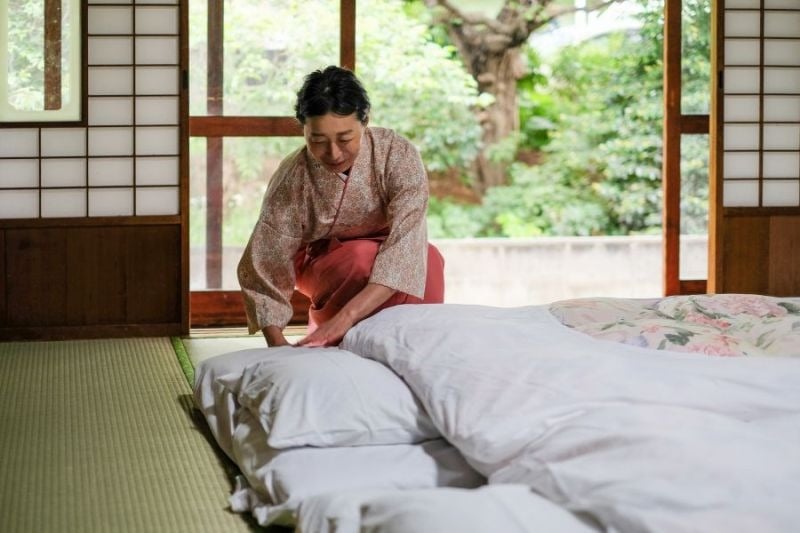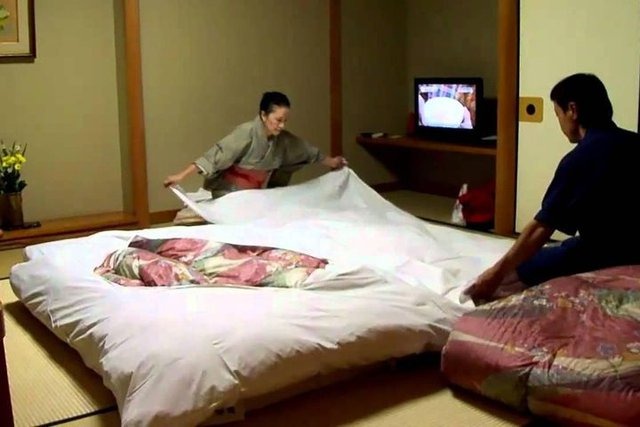You may be familiar with the idea of lying down on a comfortable bed. However, when stepping into a Japanese-style bedroom, you may not see any beds at all. In fact, in Japan, most families sleep on the floor. So why is that?
Maximizing space
With a reputation as a “small land – big population” country, Japan faces high population density, especially in large cities. This population concentration leads to small apartments in urban areas with limited space. Therefore, the Japanese people often get creative in maximizing living space by using means such as thin walls or sliding doors to divide space.
They often transform the living room into a bedroom by using tatami mats – a lightweight and compact type of mat that has many applications, helping optimize living space.

With a reputation as a “small land – big population” country, Japan faces high population density, especially in large cities.
In addition, with the prevalence of low houses in Japan, using beds can cause issues such as hitting the ceiling. By removing the beds, the floor space becomes more open and creates a sense of high and spaciousness.
Earthquake detection
With about 1,500 earthquakes per year, Japan frequently experiences geological movements. The country’s geographic location, at the intersection of two major tectonic plates, is the main cause of this phenomenon. Therefore, sleeping on the floor helps Japanese people easily detect underground movements and be prepared to react in time. Moreover, it also allows them to move quickly in case of emergency without obstacles from furniture.
Economical
Another reason why the Japanese people don’t use beds is to save money. Instead of buying a bed, they only need to invest in a set of tatami mats for the summer and quilts, mattresses for the winter. This not only saves money but also avoids costs related to maintaining, repairing, or designing beds.
Safety for children
Using a mattress directly on the floor helps protect young children from the risk of falling off the bed, getting injured, or getting stuck in bed components. This ensures safety and peace of mind for parents.
Health benefits
Sleeping on a flat, firm surface can alleviate back pain that you may have endured for many years. On the other hand, sleeping on a soft bed, although initially comfortable, over time, the mattress can sag, leading to spinal curvature and back pain. Therefore, sleeping on the floor keeps the spine straight, preventing the body from being forced into an unnatural position.

Sleeping on a flat, firm surface can alleviate back pain that you may have endured for many years.
If you sleep in the correct position and with supported spine while lying on the floor, you will maintain a straight posture throughout the day. Conversely, if the spine has to bend according to the mattress surface, it will surely affect your health and change the shape of the spine. This can lead to a stooped or hunched posture.
Sleeping on the floor can also enhance blood circulation. With the supine position, this habit helps prevent numbness and itching due to poor blood circulation. On the contrary, if you curl up or lie face down on the mattress, blood flow can be reduced, causing numbness and itching in the hands and feet, and even cardiovascular problems.
Japan experiences about 1,500 earthquakes per year due to its geographic location. Sleeping on the floor allows them to easily detect underground movements and react quickly in an emergency, unimpeded by furniture.
Yes, by forgoing beds, the Japanese save money on the initial purchase, maintenance, repair, and design costs associated with beds. Instead, they invest in more affordable and versatile tatami mats, quilts, and mattresses.
Using a mattress directly on the floor eliminates the risk of young children falling off the bed and getting injured. It provides peace of mind for parents concerned about their children’s safety.
Sleeping on a flat, firm surface can alleviate back pain and maintain a straight spine, preventing unnatural body positions. It also enhances blood circulation, reducing numbness and itching. Conversely, soft beds can sag over time, leading to spinal curvature issues.






































